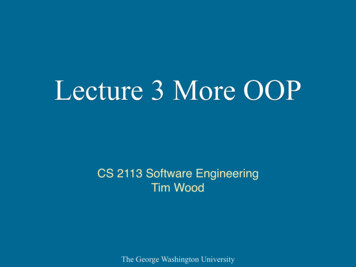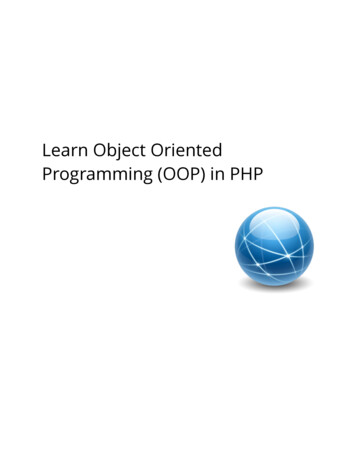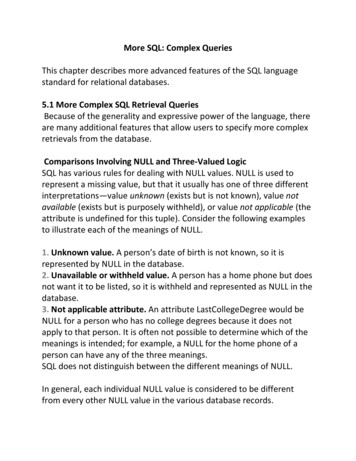
Transcription
Lecture 3 More OOPCS 2113 Software EngineeringTim WoodThe George Washington University
O.O. Design Modern software engineering is largely aboutdesigning classes, deciding how they relate, anddeciding their functions data Good design: is simple: remove unnecessary classes, functions, and data is compartmentalized: separate functionality, isolate data has clean interfaces: inputs and outputs should make sense is reusable: create general purpose code when possible!2
UML Unified Modeling Language Formal way to describe programs, components, functionality Designed for any object oriented programming language Defines 14 standard diagram types Structural diagrams Defines the piecesof the system andtheir relationships Behavioral diagrams Describe how the piecesinteract!3
Class Diagrams Tell us how different classes are related Lists key methods and data!4
Simplified Class Diagrams How are these related? Human, Student, Hand, Pen, and Pencil?HumanPenHandStudentPencil"is a""associated with"!5
Class Diagram ExampleClass diagrams describe the software'scomponents and how they relateHumanhas 2HandholdsownsPenWritingUtensilStudentPencil"is a""associated with"!6
Arrow Direction The arrow shows which class must knowsomething about the other A child must "know" about its parent so it canextend it The parent can be oblivious to that factHumanHand"associated with"Student"is a” (inherits from)!7
From Diagram to CodeHumanHandPenStudentWritingUtensilPencilpublic class Human {protected Hand leftHand;protected Hand rightHand;public class Studentextends Human{private WritingUtensil wu;public Human() {leftHand new Hand();rightHand new Hand();}public Student() {super();wu new Pen();rightHand new Hand(wu);}}}!8
Adding More Detail Full UML diagrams also include: Attributes (class data elements) Methods (class functions)HumanStudentname: Stringage: intleftHand: HandrightHand: Handschool: Stringmajor: Stringwalk()eat()sleep()study()goToClass()lists the dataand functionsadded to theparent class Also uses a whole bunch of arrow types!9
Voice Mail System Problem description:Phone rings, is not picked up, callerinvited to leave message; owner ofmailbox can later retrieve message Is that enough to build the system? Requirements Engineering Science behind formally specifying what a system must do!10
Deciding on the parts Things: MailboxesMessagesUsersPhone numbersDatesA voice mail system recordscalls to multiple mailboxes.The system records eachmessage, the caller's number,and the time of the call. Theowner of a mailbox can playback saved messages. Actions: Record messageReplay message.Remove messages?Next/Previous Message?!11
MailSystem Class Diagram What are the components? What are their important functions and data? How are they related? Annotate arrowsInherits fromWork with 1-2other studentsand draw yourdiagram on theworksheetMakes use of!12
MailSystem Class Diagram What are the components? What are their important functions and data? How are they related? Annotate arrowsInherits fromClient request: Wealso want to supporttext messages on thesame system!Makes use of!13
How do things interact? Class diagram tells who interacts with who But doesn't illustrate how they interact UML Sequence Diagrams Show the steps required to do something!14
Good Practices Diagram should be loosely connected Only make a class depend on another if it really needs it Use Inheritance to replace similar functionality Red balls, green balls, and orange squares Chickens, cows, and tanks Focus on key features and level of detail UML can be a waste of time, so apply to the useful parts Iterate design and implementation Don't try to do everything the first time Build and test components in stages!15
UML Tool Violet UML tool makes it easy to draw diagrams Homepage: http://alexdp.free.fr/violetumleditor/ Download from 2113 Java Module 3 page!choose mode:SelectClassInherits from.Is associated.double clickto edit!16
Banking Use VioletUML to represent the following programYou have been hired by a bank to write software to track its accounts andclients. Your bank software must keep track of two kinds of accounts: Checkingand Savings. Both these account types should support making deposits andwithdraws. The Checking account should also allow customers to write a checkand the Savings account should support adding interest.The bank needs to be able to keep track of all of its customers, each of whommay have one or more accounts. Every month, the bank needs to be able toprint out a list of customers and the balance inside each of their accounts. Youcan assume that all customers have a unique name and that bank accountsare assigned a unique ID number.Draw a UML diagram to represent the software you would design to handle thisscenario. Be sure to mark the important functions and data members for eachclass, and use the different arrow types to indicate which classes inherit or areassociated with others.!17
Quiz time! Hopefully you finished Java Module 2 and readthrough the book! Solve the questions on the worksheet Put your answers here: https://goo.gl/forms/1S05DoW2S45yqTrv1 You may use: Java Module 2 slides The REPL editor The GitHub Gist site Your Gist address should be something like: 80dd461cc9bf11!18
Classes and Memory UML Class Diagrams help us visualize relations Write the codefor these classes Just define the functionsand data members Fill in worksheet Ignore the main function and memory layout for now You do not need to fill in the method content, just put the namesof methods and variables in the right places!19
Classes, Objects, and Memory What will memory look likeafter running this code?public class Vehicle {public int speed;private int acceleration;public static int count;// .}public class Car extends Vehicle {private String model;public void turnKey(){ 6cHeapAddressContents500000public static void main() {int s 65;Vehicle v;Vehicle v2 new Vehicle();v2.speed s;Car c new Car("Honda");c.count 50;}!20
Static Object MemoryStack// A simple static object. Note: all members (data and methods)// are declared with the "static" keyword.class ObjX {static int i;static void print (){System.out.println ("i " i);}Heap} // All static members// The class that has "main"public class StaticExample {public static void main (String[] argv){// Refer to a member of ObjX using the class name.ObjX.i 5;Globals// Call a method using the class name and dot-operator.ObjX.print();}}!21
Dynamic Object MemoryStack// Dynamic object definitionclass ObjX {int i;void print () {System.out.println ("i " i);}Heap} // NO “static” for either member!public class DynamicExample1 {public static void main (String[] argv){// First create an instance with space from the heap.ObjX x new ObjX ();Globals// Now access members via the variable and the dot-operator.x.i 5;x.print();}}!22
Static/Dynamic (HW)Stack// Static reference to dynamic objectclass ObjX {int i;void print () {System.out.println ("i " i);}Heap} // same as beforepublic class DynamicExample2 {// A simple variable declaration.static ObjX x;public static void main (String[] argv){// First create an instance, with space from the heap.x new ObjX ();// Now access members via the variable and the dot-operator.x.i 5;x.print();}Globals}!23
Multiple ObjectsStack// Multiple dynamic objectsclass ObjX {int i;void print () {System.out.println ("i " i);}} // same as beforeHeappublic class DynamicExample3 {public static void main (String[] argv){// Create an instance and do stuff with it.ObjX x new ObjX ();x.i 5;x.print();Globals// Create another instance assigned to the same variable.x new ObjX ();x.i 6;x.print();}}!24
Multiple Objects 2 (HW)Stack// Multiple dynamic objectsclass ObjX {int i;void print () {System.out.println ("i " i);}} // same as beforeHeappublic class DynamicExample4 {public static void main (String[] argv){// Create an instance and do stuff with it.ObjX x new ObjX ();x.i 5;x.print();Globals// Create another instance assigned to the same variable.ObjX x2 new ObjX ();x2.i 6;x2.print();}}!25
Arrays of Objects (HW)Stack// Multiple dynamic objectsclass ObjX {// same as before}public class DynamicExample5 {public static void main (String[] argv){// Make space for 4 ObjX pointers.ObjX[] xArray new ObjX [4];// Make each of the 4 pointers point to ObjX instances.for (int k 0; k 4; k ) {xArray[k] new ObjX ();}// Now assign data to some of them.xArray[0].i 5;xArray[1].i 6;// Print all.for (ObjX x: xArray) {x.print();}}}HeapGlobals!26
Arrays of Objects v2 (HW)Stack// Multiple dynamic objectsclass ObjX {// same as before}public class DynamicExample6 {public static void main (String[] argv){// Make space for 4 ObjX pointers.ObjX[] xArray new ObjX [4];// Use fancy for loop syntax.for (ObjX x: xArray) {x new ObjX ();}// Now assign data to some of them.xArray[0].i 5;xArray[1].i 6;// Print all using fancy for loop syntax.for (ObjX x: xArray) {x.print();}}}HeapGlobals!27
Where Does it Go? In C we had to call "free()" to make sure that thememory we used was cleaned up How come we don't need to do this in Java?MyLinkedList L new ;L.remItemAt(0);L.remItemAt(0);!28
Garbage Collection The Java Run Time automatically tracks whatobjects are actively being used in memoryMyLinkedList L new ;L.remItemAt(0);L.remItemAt(0);0head213!29
Garbage Collection The Java Run Time automatically tracks whatobjects are actively being used in memory If no variable references something, then that object is"lost"---can be deletedMyLinkedList L new ;L.remItemAt(0);L.remItemAt(0);0head213!30
How might it do this? How to find which objects on the heap arereachable (or not)? Program knows: List of all objects that have been created List of references from the Stack and Globals area!31
Garbage Collection The Java Run Timeautomatically trackswhat objects are stillused in memoryMyLinkedList L new tents10000List ntentshead &50040value 0, next &50024value 1, next &50040value 2, next &50056value 3, next null213!32
Mark, Sweep Basic garbage collection algorithm Goal: find objects on the heap that are notreferenced by any active object Maintain a list with a reference to all heap objects Include a "referenced bit" with each object: 1 used, 0 lost Mark Phase: Start from the root known object (e.g. top of stack) Set referenced bit to 1 for every object it references Sweep Phase: Step through list of all objects, delete anything not referenced!33
Garbage Collection The Java Run Time automatically tracks whatobjects are actively being used in memory If no variable references something, then that object is"lost"---can be deletedStackMyLinkedListL Contents NameMyLinkedList();10000 newListL&50000L.add(0);L.add(1);L.add(2); head &5004050008value 0, next &50024L.remItemAt(1);50024value 1, next &50040L.remItemAt(0);50040value 2, next &5005650056value 3, next null0head213!34
Benefits and Costs of GC Benefits: No "memory leaks" from forgetting to free Tighter control helps security Drawbacks: May need to completely stop application while runninggarbage collection Leads to unpredictable performance Newer garbage collectors support parallelism Just because there is a reference, doesn't mean it will beactively used again in the future!35
!36
UML Unified Modeling Language Formal way to describe programs, components, functionality Designed for any object oriented programming language Defines 14 standard diagram types Structural diagrams Defines the pieces of the system and their relationships Behavioral diagrams Describe how the pieces interact!3. Class Diagrams Tell us how different classes .











